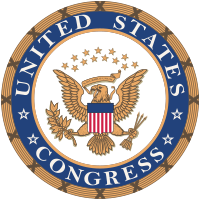Congress Committee
A congressional committee ( Congressional Committee ) is within the political system of the United States a subunit of the Congress , which deals with a particular subject area.
In the House of Representatives , the committees play a stronger role due to the size of the Chamber (the House of Representatives has 435 MPs, while the Senate has only 100 Senators).
Committees have played an important role in the United States parliamentary system from the start, and it has grown over time. The first House Committee was appointed on April 2, 1798 to prepare rules of procedure for the work of the House and to establish the duties of the Sergeant at Arms of the United States House of Representatives , a type of parliamentary security officer. The first Senate Committee was established on April 7, 1789 to draft rules of procedure for the Senate.
Current committees
There are three main types of committees: Standing Committees , Select or Special Committees, and Joint Committees . The current structure and organization of the Congressional Committees was established in 1946 by the Legislative Reorganization Act . As a result of this law, the number of standing committees of the House of Representatives was reduced from 48 to 19, and the number of standing Senate committees from 33 to 15. The responsibility of the individual committees was established by law at that time, whereby numerous committees could be merged or abolished. There are 21 standing committees in the House of Representatives today. They are called permanent because they last for the entire legislative period and deal with more general issues. There are 20 standing committees in the smaller Senate.
In addition to the standing committees, there are investigative or special committees. These are brought into being by a separate resolution of one of the two chambers of the Congress in order to carry out a special investigation or to advise on certain measures. Committees of inquiry often deal with emerging issues that do not fit within the designated areas of the standing committees or exceed the jurisdiction of more than one standing committee. A committee of inquiry can be temporary or permanent. All currently existing committees of inquiry in both chambers meet permanently. In the Senate, committees of inquiry are sometimes referred to as special committees; B. The United States Senate Special Committee on Aging .
There are also five joint committees. These are also bodies that meet permanently and consist of members from both chambers. These include the Conference Committee , which is comparable to the German Mediation Committee and is used during the legislative process. When the draft bill differs between the Senate and the House of Representatives, the Conference Committee is called to mediate between the Houses and reach an agreement.
Most committees also have one or more sub-committees.

